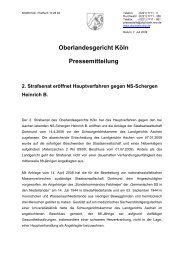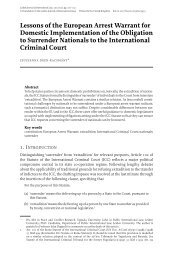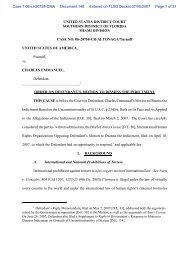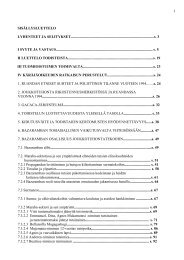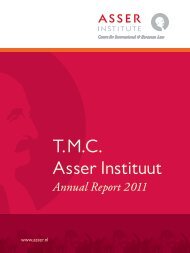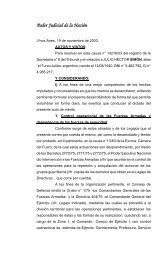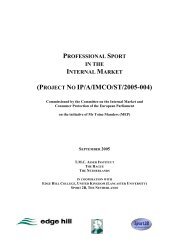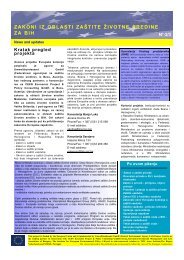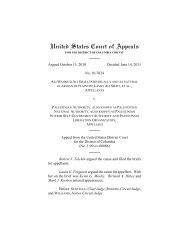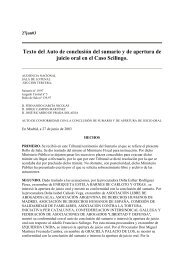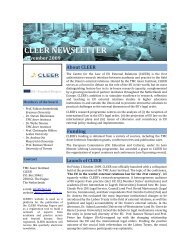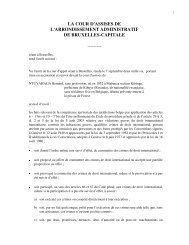Islj 2009 3-4 - TMC Asser Instituut
Islj 2009 3-4 - TMC Asser Instituut
Islj 2009 3-4 - TMC Asser Instituut
Create successful ePaper yourself
Turn your PDF publications into a flip-book with our unique Google optimized e-Paper software.
The RFL may declare that a player who does not comply with the<br />
rule’s requirements is nonetheless “federation trained” or “club<br />
trained” provided the player demonstrates that he ‘satisfies the spirit of<br />
the definition’. 16 Failure to comply with the “club trained rule” is an act<br />
of misconduct. 17 Penalties imposed against a club for an infringement<br />
of the rule include: a fine; the deduction of competition points; or the<br />
requirement that a club play its games behind closed doors (amongst<br />
others). 18<br />
Background<br />
Before examining the legality of the rule under Article 81 (EC) it is<br />
pertinent to consider the context in which the sport was played<br />
immediately prior to the rule’s introduction. The information summarised<br />
below is extrapolated from interviews conducted with industry<br />
stakeholders during 2007. 19<br />
1. The Principal Pathway Into Employment in the Super League<br />
Competition<br />
In 2007 the principal pathway for a player into a full time professional<br />
career at a Super League club was through participation in rugby<br />
league at school or an amateur club. The RFL - then as now - divides<br />
the United Kingdom geographically into service areas which are based<br />
on metropolitan council boundaries. Talented junior players are selected<br />
from amateur clubs to play “service area” rugby. The service area<br />
competitions are divided into age levels (for example, under-15, under-<br />
14, and so on). Players who participate in service area competitions are<br />
also likely to attend regional and national rugby league training camps.<br />
A scholarship scheme runs in conjunction with the various service<br />
area, amateur and school competitions. Pursuant to the scheme a professional<br />
rugby league club provides an annual scholarship to a player<br />
aged seventeen years or under. The player receives advice on nutrition<br />
and fitness and is permitted to train with the professional club. The<br />
RFL Scholarship Scheme Rules regulate the scheme. 20<br />
At seventeen years of age a player is eligible for employment in a<br />
Super League club academy team and from the academy may obtain<br />
a contract as a full time professional player in the first team of a Super<br />
League club. Those players who do not obtain employment in a first<br />
team may seek employment as a part time professional player in the<br />
competition divisions below Super League or leave the industry altogether.<br />
21<br />
Rugby League Club and any other Rugby<br />
League Football club or other body which<br />
may be invited to join the RFL from time<br />
to time’: RFL Operational Rules <strong>2009</strong>,<br />
1(k).<br />
15 RFL Operational Rules <strong>2009</strong>, B1:11B(c).<br />
16 RFL Operational Rules <strong>2009</strong>, B1:15.<br />
17 RFL Operational Rules <strong>2009</strong>, D1:10(r).<br />
18 RFL Operational Rules <strong>2009</strong>, D1:12.<br />
19 Those stakeholders interviewed included:<br />
Super League clubs, Championship<br />
clubs (the competition division below<br />
Super League), professional rugby league<br />
players, the RFL, the Rugby League<br />
Players’ Association, professional coaches,<br />
and sports agents.<br />
20 RFL Operational Rules <strong>2009</strong>, E9.<br />
21 There are two competition divisions<br />
below Super League: the Championship;<br />
and Championship 1.<br />
22 Personal interview with Super League<br />
Club D (February 2007).<br />
23 Personal interview with Championship<br />
Club A (November 2007).<br />
24 Personal interview with Super League<br />
Club F (May 2007).<br />
2. Factors That Influenced Recruitment Decisions<br />
In 2007 professional players were typically recruited to a Super League<br />
club’s first team from: the club’s academy; other Super League clubs;<br />
the Australian NRL clubs; and Championship clubs. Factors that<br />
influenced a club’s decision to recruit a player were: the player’s skills;<br />
the player’s contract costs; the salary cap; a player’s personal attributes<br />
and character; whether the player fitted within the team dynamic; the<br />
player’s potential off-field contribution to the club; the player’s experience<br />
and/or age; the player’s public profile, and the player’s potential<br />
to add-value to the club’s brand and generate income for the club’s<br />
sports business. The effect of a player’s recruitment for the development<br />
of the Great Britain international representative team was not a<br />
consideration for a majority of the British clubs.<br />
Nationality was a factor in the recruitment decisions of the French<br />
club, Catalans Dragons. A goal of the club was to develop French<br />
rugby league and the calibre of French professional rugby league players.<br />
Of 28 players employed at the time of interview in 2007, twenty<br />
players were French and eight players were from Australia and New<br />
Zealand.<br />
The majority of British clubs interviewed preferred to recruit players<br />
residing locally rather than foreign players. However, information<br />
extrapolated from interviews suggested that a shortage of skilled professional<br />
players existed in the northern hemisphere. As one club sta -<br />
ted:<br />
‘…the policy we have is to recruit the best players available to ensure<br />
we have the best possible team from whatever origin that is.…As an<br />
individual club we would rather recruit English players than overseas<br />
players but the quality isn’t always there in the English players that it<br />
is in the overseas players, particularly in the Australian players’. 22<br />
The majority of British clubs interviewed commented that it was not<br />
cost effective to recruit a foreign player when compared to the cost of<br />
investment in an academy or junior player development. One club<br />
stated that it was cost effective in the short term. The cost of recruiting<br />
a foreign player was described as including: the player’s salary;<br />
transport costs to and from the United Kingdom; accommodation<br />
costs; and the costs associated with providing a car. In some cases, it<br />
also included the costs of relocating the player’s family. The cost of<br />
developing a player in the academy was described as the player’s salary<br />
plus the money invested in junior player development. Over time the<br />
cost of developing a junior player was cheaper than recruiting a foreign<br />
player. The recruitment of a foreign player was described by<br />
some British clubs as a “short term” or “easy option” when compared<br />
to the time taken to develop a junior player.<br />
3. Factors That Influenced Club Demand For Foreign Players<br />
In 2007 the factors that influenced Super League club demand for<br />
foreign players were: the threat of relegation from the competition;<br />
the means of entry for a club into the competition; a shortage of<br />
skilled local players; and the financial benefit accruing to a club from<br />
the employment of a foreign player (particularly a high profile player).<br />
One club described increasing its recruitment of foreign players<br />
during the playing season in order to avoid relegation. Those clubs<br />
interviewed that entered the competition by way of promotion from<br />
the division below Super League commented that the recruitment of<br />
foreign players increased following promotion. The point in time at<br />
which promotion was confirmed; and the non-availability of skilled<br />
players in the local labour market contributed to an increased demand<br />
for foreign players. According to one club:<br />
‘There aren’t very many players around once you get promoted and you<br />
look where you can. Most of the quality English players are all signed<br />
because generally people would prefer to sign English players rather than<br />
overseas players so then you look overseas where there are a lot more players<br />
in Australia and New Zealand, particularly in Australia where there<br />
are a lot more people playing the game there than what there are here.’ 23<br />
London Broncos (now Harlequins RL) entered the Super League<br />
competition in 1995 and Catalans Dragons was admitted by agreement<br />
of the existing Super League clubs in 2006. Both clubs were provided<br />
with an exemption from the “overseas quota rule” which<br />
enabled the clubs to recruit an increased number of foreign players.<br />
The exemption was provided owing to a shortage of skilled players in<br />
the local labour market.<br />
Finally, one club reported that recruitment of a high profile foreign<br />
player had positive financial effects for a club’s sports business:<br />
‘You know when [name omitted for reasons of confidentiality] came<br />
over to play for us, did it have an uplifting factor on all of the squad here?<br />
Absolutely. The whole borough wide community. Shop sales, lottery sales,<br />
everything benefited….’ 24<br />
4. Foreign Players in the Super League Competition<br />
According to those industry participants interviewed, foreign players<br />
benefited the competition, clubs and consumers in a number of ways.<br />
First, foreign players brought to the Super League competition: new<br />
playing skills; experience of development, training and playing meth-<br />
A RT I C L E S<br />
<strong>2009</strong>/3-4 39



